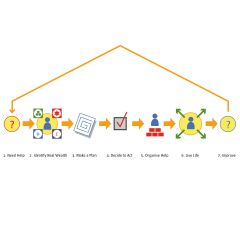Self-directed support is the 7 step process by which people obtain control over their support in order to achieve a better life for themselves.
Author: Simon Duffy
Self-directed support is the process of taking control of your life and any support you might need to live it. Although self-directed support was developed for adult social care services its application is much wider and even goes beyond public services.

Self-directed support has emerged from the work of disabled people and many other groups who have found that getting support from others can threaten their independence and citizenship. Self-directed support has been used by the Independent Living Movement, the Inclusion Movement and the Recovery Movement to help return authority and control back to the citizen.
The seven-step model of self-directed support described here was first developed by Simon Duffy in North Lanarkshire in 2000, and then adopted and promoted by In Control in 2003. The model was clearly influenced by the Drexler and Sibbet ‘Team Performance Model’ (www.grove.com) and in 2009 Duffy revised the model to make clearer that individual budgets were not an essential component of self-directed support and to demonstrate its wider application in education, health care and community development.
In real life the process of planning and implementation is cyclical and can often be fragmented or confused. But nevertheless the following framework is useful, especially if we remember that people may be at different stages and that the seventh steps will always bring you back to the first:
1. Identifying need - Planning begins with an awareness of a need, the existence of a problem to solve or a goal that we wish to achieve. Primarily we offer people help, advice and an assessment of their needs in order to help them come to an understanding of those needs, and in order to help them take control of responding to the needs themselves. Without some meaningful goal (positive or negative) self-direction is impossible.
2. Mapping & exploring resources - People have assets, gifts, relationships or networks - services are only part of what people want or need. It is by planning in the context of an holistic understanding of our own assets, networks, rights and resources that we can develop plans which make sense to us. The advantage of systems of individual funding like individual budgets are that they clarify the level of funding as a flexible entitlement which then allows people to plan how best to use that entitlement in the context of their wider life. In general making entitlements clearer and more flexible will tend to facilitate self-directed support. This step is also clearly linked to the concept of Real Wealth.
3. Designing your own support plan - People need plans which are consistent with needs and preferences and therefore underpinned by their own real motivations. A plan which is not rooted in your own desires and motivations will not be sustainable. Moreover such planning often does not require professional support. Many people have found that they can get support from friends, family or others who have shared their experiences in order to develop helpful plans which better support their mental health. Tools or guidance which makes planning easier for people to do for themselves can be very useful too; but a plan does not have to be written down and standardised planning structures can threaten autonomy and creativity.
4. Negotiating & agreeing support - For most of us planning ends when we decide to take action, to implement our plan. If our plan does not require the involvement of others then this step is simply a matter of making a personal decision. However if we rely on the agreement of others, e.g to spend an individual budget, act collectively or use other resources or services, then we may well need other people’s permission or agreement.
5. Organising your support - Services and supports should be managed and organised so that control is as close as possible to the person and support can be changed quickly and easily as needs change or as new opportunities or risks emerge. The key to high quality support is not good planning but the ability to respond quickly to problems or failings - we learn by doing.
6. Using and developing your support - Services and supports should be organised to respect and strengthen the individual’s lifestyle, gifts and community connections. They should help people achieve socially valued goals and outcomes that are defined by the person. Often the best support comes from people who share things in common: interests, communities, language, culture etc. Support which is not sensitive to our own nature not be will be competent.
7. Reflecting - Personal and organisational development and learning is impossible without time to reflect on what is working and what can be improved. Structuring opportunities to reflect, amend and improve is vital to improving quality.
It is also important to note that self-directed support can be applied even when rationality is impaired by a crisis or a long-term condition. When the person can only make decisions with the help of others then self-directed support is still possible.
The publisher is the Centre for Welfare Reform.
Self-Directed Support © Simon Duffy 2010.
All Rights Reserved. No part of this paper may be reproduced in any form without permission from the publisher except for the quotation of brief passages in reviews.
Self-Directed Support, social care, England, Inspiration